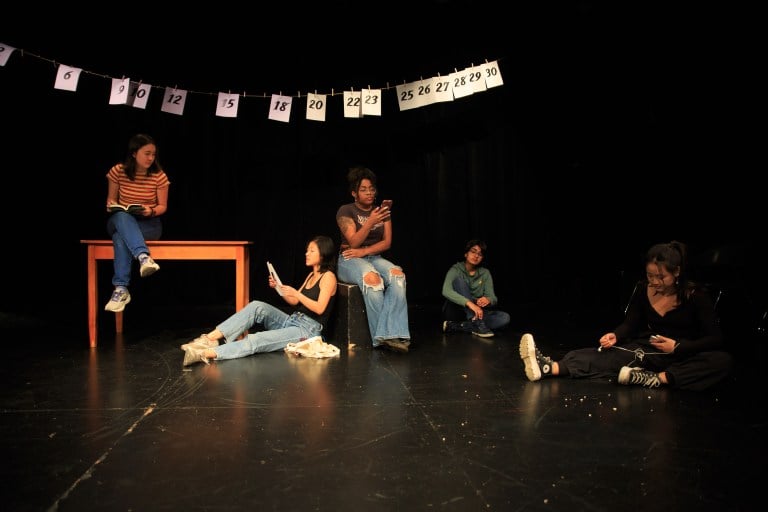Have you ever seen a live show and thought, “I can tell that these actors are acting”? In “Everything Must Go,” that is exactly the goal, and it was executed with perfection.
The to-the-minute hour-long Theater Lab show was performed at the Nitery Theater on Dec. 1, 2 and 3. It was produced in the style of “The Infinite Wrench,” a show by the San Francisco Neo-Futurists in which the cast attempts to perform 30 original plays in 60 minutes.
The Neo-Futurist style destroys the escapism offered by theater, which can be dangerous or scary for actors and audience alike. However, “Everything Must Go” allowed space for the audience to become comfortable with the uncomfortable, lean into the humor and sit with the deeper topics, all in a span of just 60 minutes. The combination of audience participation, non-illusory acting and wittily written short plays made for a lively, truly heartfelt and deeply memorable show.
Each audience member had a program in their hands with the titles of each of these plays listed as numbers 1 through 30, and every time an actor on stage called “curtain,” the audience had to shout out the number of the play they wanted to see next.
The plays varied in topics: mocking Stanford students (“What Marriage Pact Questions Sound Like In Real Life”), teaching about calcification in the ocean (“Ocean Talks About Acid”), diving into the depths of an actor’s personal life (“Childhood Misbeliefs”) and even giving an audience member a haircut (“Free Haircut!”). Certain plays contained jokes or props that were then used throughout the rest of the show, like number 25, “drinking a shake,” in which one cast member brought out a McDonald’s milkshake and drank it throughout the rest of the show.
Because the audience determined the order of the show, there were often unanticipated tone shifts, quickly jumping from one topic to the next. The unpredictability added to the comedic element of the show but also made the audience think about each play in the context of the one they saw last, making them take on new meanings at times.
One segment of the Friday show went from number 1 to number 22 to number 8 without time in between even to clap. They jumped from a play where an audience member called their mom in front of everybody to another about “Philosophical Thoughts on Suicide,” to yet another where the lights were turned to the audience: the cast dragged chairs onto the stage and watched us sit there uncomfortably. Some audience members danced, and others started singing — it was brief and silly and somewhat strange, which seemed to be exactly the goal of the production.
In true Neo-Futurist, non-illusory style, number 17, titled, “God is a Woman,” showed the audience the stage manager, who controlled the play from inside a booth to the left of the stage. She gave lighting cues, sound cues and stage directions, demonstrating her power to make the show run smoothly or not-so-smoothly. For the rest of the show, the audience was aware of her presence, especially during plays like “Fast Dances to Slow Songs,” where the actors did a TikTok-esque style dance to Fionna Apple’s cover of “Why Try to Change Me Now.”
This Neo-Futurist style of performance hopes to break down the fourth wall between the audience and actors so that everyone can be conscious of where they are and what they are doing together. As dramaturg Jayda Alvarez ’24 wrote to the audience, “The point of non-illusory theater is that there are no pretenses about what is happening on stage. We are not characters in another place in another time — we are Stanford students at the Nitery theater on a weekend in December.”
Editor’s Note: This article is a review and includes subjective thoughts, opinions and critiques.
